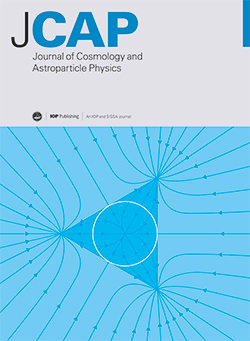Numerical analysis of melting domain walls and their gravitational waves
IF 5.3
2区 物理与天体物理
Q1 ASTRONOMY & ASTROPHYSICS
Journal of Cosmology and Astroparticle Physics
Pub Date : 2025-02-26
DOI:10.1088/1475-7516/2025/02/064
引用次数: 0
Abstract
We study domain walls (DWs) arising in field theories where Z2-symmetry is spontaneously broken by a scalar expectation value decreasing proportionally to the Universe temperature. The energy density of such melting DWs redshifts sufficiently fast not to overclose the Universe. For the first time, evolution of melting DWs and the resulting gravitational waves (GWs) is investigated numerically using lattice simulations. We show that formation of closed melting DWs during radiation domination is much more efficient compared to the scenario with constant tension DWs. This suggests that it can be the main mechanism responsible for reaching the scaling regime similarly to the case of cosmic strings. However, the scaling behaviour of melting DWs is observed, provided only that the initial scalar field fluctuations are not very large. Otherwise, simulations reveal violation of the scaling law, potentially of the non-physical origin. The spectrum of GWs emitted by melting DWs is also significantly different from that of constant tension DWs. Whether the system has reached scaling or not, the numerical study reveals a GW spectrum described in the infrared by the spectral index n ≈ 1.6 followed by the causality tail. We attribute the difference from the value n = 2 predicted in our previous studies to a finite lifetime of the DW network. Notably, the updated index is still in excellent agreement with the recent findings by pulsar timing arrays, which confirms that melting DWs can be responsible for the observed (GW) signal. We also point out that results for evolution of melting DWs in the radiation-dominated Universe are applicable to constant tension DW evolution in the flat spacetime.求助全文
约1分钟内获得全文
求助全文
来源期刊

Journal of Cosmology and Astroparticle Physics
地学天文-天文与天体物理
CiteScore
10.20
自引率
23.40%
发文量
632
审稿时长
1 months
期刊介绍:
Journal of Cosmology and Astroparticle Physics (JCAP) encompasses theoretical, observational and experimental areas as well as computation and simulation. The journal covers the latest developments in the theory of all fundamental interactions and their cosmological implications (e.g. M-theory and cosmology, brane cosmology). JCAP''s coverage also includes topics such as formation, dynamics and clustering of galaxies, pre-galactic star formation, x-ray astronomy, radio astronomy, gravitational lensing, active galactic nuclei, intergalactic and interstellar matter.
 求助内容:
求助内容: 应助结果提醒方式:
应助结果提醒方式:


